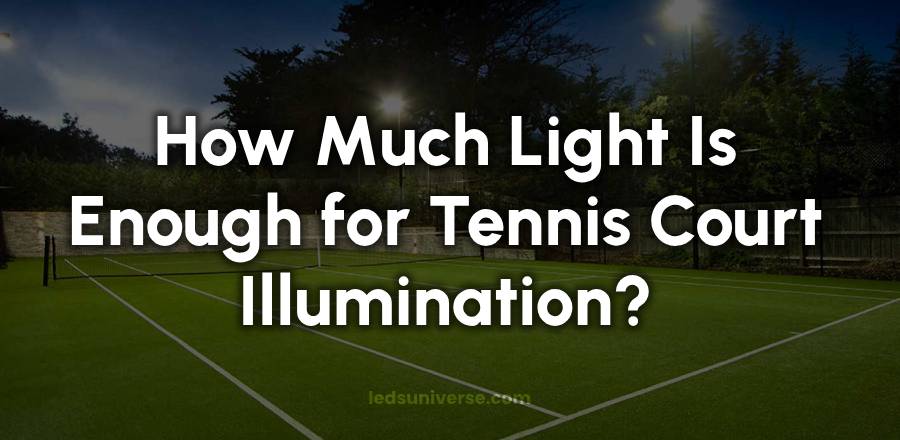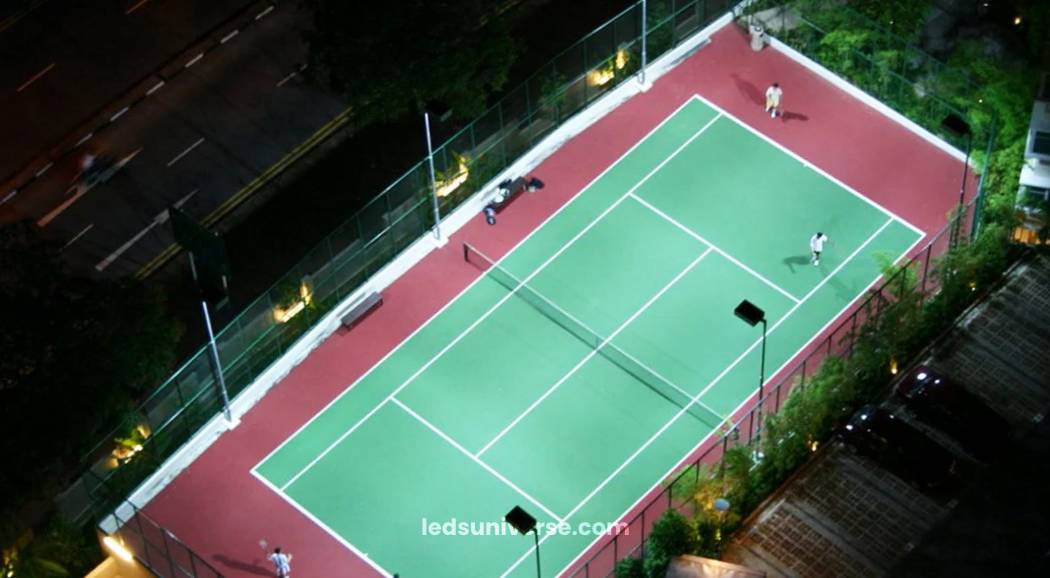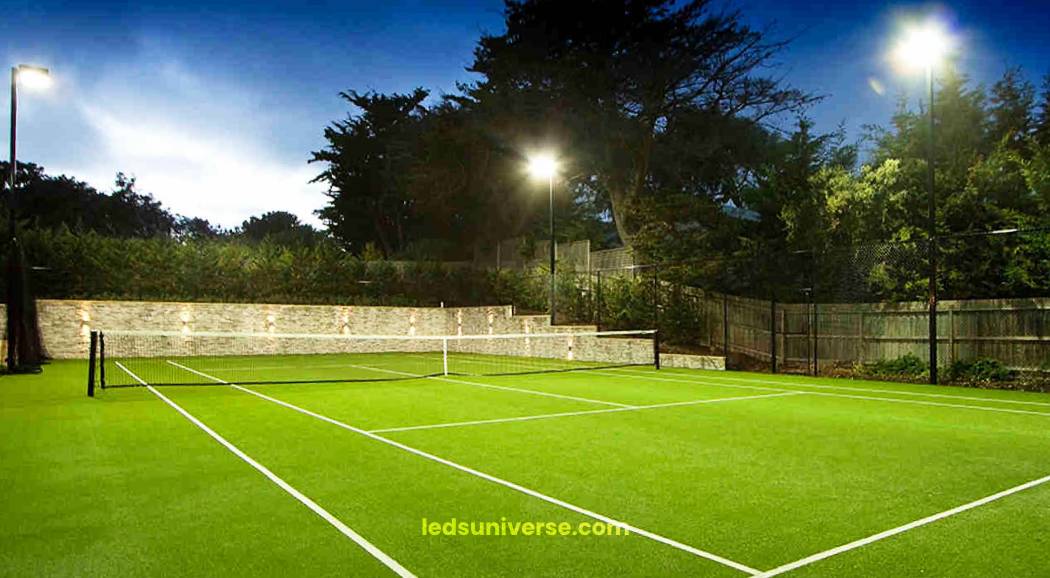
Tennis, a sport defined by speed, precision, and endurance, relies heavily on the visibility of its fast-moving ball. While the intensity of natural sunlight is ideal during daytime play, the ability to extend games into the evening or play indoors requires a thoughtful and strategic approach to artificial lighting.
Proper lighting ensure that players can perform optimally, regardless of the time of day or weather conditions. With advancements in lighting technology and increased awareness of energy consumption, there are now various solutions for providing adequate lighting for different types of tennis courts, ensuring a consistent and well-lit playing environment.Understanding the requirements for tennis court lighting involves examining several factors such as court type, surface material, lighting distribution, and fixture options. It also involves recognizing international standards for light intensity and uniformity.
Reach out for free lighting consultation
Table of Contents
ToggleThe design of a tennis court lighting system must account for the type of court and the environmental conditions it faces. Outdoor and indoor courts have distinct lighting needs, each influenced by the unique characteristics of their settings.

Outdoor courts are exposed to the elements, which makes lighting design more complex. The surface of the court—whether grass, clay, or hard court—affects how much light is absorbed and reflected. Grass courts, with their low reflectivity, require higher lighting levels to ensure adequate illumination. Clay courts absorb light as well, though they are somewhat more reflective than grass, while hard courts are more reflective, requiring fewer fixtures or lower-intensity lighting. Furthermore, weather conditions, like fog or rain, may impact lighting efficiency, making it essential to design outdoor lighting systems that remain effective under various conditions.
These courts require strategically placed fixtures to prevent shadows and glare while ensuring uniform illumination. Professional indoor courts, such as those used for televised tournaments, must meet strict lighting requirements to ensure that both players and viewers have clear visibility. The setup for indoor courts typically involves overhead fixtures, with careful consideration of the height and positioning to avoid glare and ensure that every part of the court is illuminated consistently.
Tennis court lighting standards are set by regulatory bodies such as the International Tennis Federation (ITF) and the United States Tennis Association (USTA). These guidelines ensure that the lighting provides the proper visibility for players while meeting safety standards. Complying with these regulations helps ensure that lighting is effective, cost-efficient, and environmentally responsible.
Lux, the unit for measuring light intensity, is used to set lighting requirements for tennis courts. For recreational play, the recommended lux level is typically between 200 and 300 lux, providing sufficient illumination for evening practice or casual matches. For competitive play, lux levels should be increased to between 300 and 500 lux to maintain visibility during faster exchanges. Professional-level matches, such as those in major tournaments, require lighting with lux levels ranging from 500 to 1000 lux to ensure clear visibility and avoid shadows or dark spots on the court.
If the light is unevenly distributed across the court, players may struggle to see the ball clearly, which can interfere with the flow of the game. For this reason, the lighting system must be designed to provide an even distribution of light across the entire court, including the service boxes, baseline, and corners. Proper fixture placement and spacing are key factors in achieving uniform lighting and eliminating any areas with insufficient light.
Tennis court lighting must adhere to local and international standards to ensure safety and fairness in play. These regulations may include rules on energy consumption, light pollution reduction, and lighting uniformity. Compliance with these standards not only ensures that the lighting system performs optimally but also helps reduce energy usage and environmental impact.

Several factors influence the effectiveness and efficiency of tennis court lighting systems. These factors must be carefully considered during the design phase to ensure that the system meets the needs of players and facility managers alike.
The size of the court determine how much lighting is required. A standard singles tennis court measures 23.77 meters in length and 8.23 meters in width, while doubles courts are wider, measuring 10.97 meters. The larger the court, the more fixtures are needed to ensure that the entire playing area is adequately lit. The spacing between lights must be carefully planned to prevent dark spots, and the height of the poles can also influence the distribution of light. Larger courts, such as those used in professional tournaments, may require more powerful fixtures to ensure even coverage.
The type of surface on the tennis court influences how much light is absorbed or reflected. Hard courts are more reflective than grass or clay courts, meaning they typically require fewer light fixtures or lower-intensity lights. Grass and clay courts absorb more light and therefore require higher lighting levels to achieve proper illumination. Understanding the reflective properties of the court surface is key to determining the appropriate lighting design for each type of court.
Glare can severely impact a player’s ability to track the ball and see the court clearly. Proper lighting design helps mitigate glare by positioning fixtures at the right angles and using shielded fixtures to control light distribution. Glare is particularly problematic on outdoor courts where natural light can interfere with artificial lighting. Ensuring that the lights do not shine directly into the players’ eyes and that light is distributed evenly across the court is essential for maintaining comfort and performance.
Choosing the right type of lighting fixtures help to achieve the desired lighting levels while also ensuring energy efficiency and reducing maintenance costs. Several different types of lighting fixtures are used in tennis court lighting, each with its own advantages and considerations.
In the past, tennis courts commonly used halogen and incandescent lamps. These lamps provide bright light but are not as energy-efficient as modern alternatives. Halogen lights, while capable of producing high light intensity, consume large amounts of electricity and have a relatively short lifespan. Incandescent lamps, although once popular, are now rarely used in modern tennis court lighting systems due to their low energy efficiency and shorter lifespan.
LED lights are widely used technology for modern tennis court lighting. LED lights offer several benefits over traditional options, including energy efficiency, long lifespan, and high-quality illumination. LEDs use significantly less power—up to 75% less energy—than halogen or incandescent lamps while providing equal or better light intensity. This makes LED lighting a more cost-effective and environmentally friendly option in the long run. LEDs can last up to 25,000 hours or more, significantly reducing the need for frequent bulb replacements and minimizing maintenance costs.
LED lighting systems also allow for greater flexibility, with the ability to adjust light levels depending on the time of day, type of play, and environmental conditions. This control over lighting intensity can enhance the player experience and reduce energy usage during non-peak hours.
Smart lighting systems are an advanced option that allows for remote control, automated dimming, and customized lighting schedules. These systems are particularly beneficial for outdoor courts, where the lighting levels may need to be adjusted based on changing weather or time of day. For example, a smart lighting system can automatically adjust the brightness based on the amount of ambient light or switch to lower levels when no one is on the court. Remote control capabilities also allow facility managers to monitor and manage the lighting system from anywhere, ensuring that lights are functioning optimally and that energy use is minimized.

Sustainability is a growing concern for sports facilities, and reducing energy consumption is a key part of making tennis courts more environmentally friendly. Choosing energy-efficient lighting systems not only saves money but also helps reduce the overall environmental impact of tennis facilities.
LED lighting is far more energy-efficient than traditional halogen or incandescent lights. By switching to LEDs, tennis facilities can reduce their energy consumption by as much as 75%, which leads to significant savings on electricity bills. This reduction in energy use also helps to reduce the carbon footprint of the facility, contributing to a more sustainable operation. Facilities that implement energy-efficient lighting also avoid the need for frequent bulb replacements, reducing the overall maintenance costs associated with lighting systems.
Solar-powered lighting systems are becoming increasingly popular for outdoor tennis courts, especially in regions that receive abundant sunlight. These systems use solar panels to capture and store energy during the day, which is then used to power the lights at night. Solar-powered lighting systems can significantly reduce electricity costs and carbon emissions, as they rely on renewable energy rather than grid power. In addition, the use of solar power eliminates the need for electricity from fossil fuels, helping to reduce a facility’s overall environmental impact.
The use of energy-efficient lighting systems like LEDs and solar-powered lights helps reduce a facility’s carbon footprint by lowering energy consumption and dependence on non-renewable energy sources. LED lights are also made from recyclable materials and have a longer lifespan than traditional lighting options, further reducing the environmental impact of tennis courts. By adopting sustainable lighting practices, tennis facilities contribute to the ongoing effort to protect the environment while maintaining high-quality lighting for their players.
Tennis court lighting is a component of creating an optimal playing environment, whether for recreational or professional purposes. The lighting system should be designed with consideration of factors such as court dimensions, surface type, and energy efficiency to ensure that it meets the needs of players and minimizes environmental impact. As technology continues to advance, LED and solar-powered lighting offer sustainable, cost-effective solutions for tennis facilities looking to reduce energy consumption while maintaining high-quality illumination for their courts. By investing in modern lighting solutions, tennis facilities can enhance the player experience, reduce maintenance costs, and contribute to a more sustainable future.